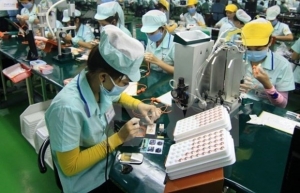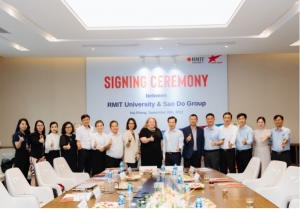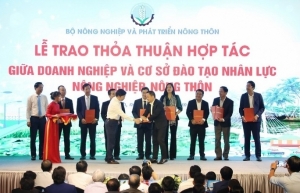Getting a head start with a big push - developing quality human resources for Vietnam
 |
| Meredith Woo - Professor, Arizona State University (right) and Jonathan Pincus - Senior international economist UN Development Programme (left) |
Since 1980, only eleven markets have increased per capita income to 50 per cent or more of the level of the United States. Eight of them were new members of the European Union, leaving only South Korea, Taiwan, and Panama as the only non-EU examples to have substantially closed the income gap with the US, escaping the middle-income trap.
The figures refer to per capita income in international (purchasing power parity) dollars in 1980 and 2019.
Countries that have escaped this trap succeeded in developing the technological and managerial capabilities that enabled them to realise increasing returns to scale, especially in export industries. They did so because they had well-established education and training systems in place, sometimes even before they began their push into export manufacturing.
Vietnam is a lower-middle-income country with ambitions to achieve high-income status by its centennial in 2045. Average GDP growth of 6.5 per cent over three decades has established Vietnam as one of the best performers in the region, enabling the country to achieve high human development status at a relatively low level of national income. Exports have increased at double-digit rates over the same period.
The government is deeply committed to its vision of breaking free and joining that small group of East Asian and European markets that have closed the gap with the world’s leading economies.
To achieve its economic ambitions, Vietnam needs to accelerate GDP growth to 8 per cent annually, sustain its export growth, and substantially increase the share of investment in GDP. Even then, the unresolved problem of Vietnam’s growth bottleneck remains. Vietnam underinvests in higher education and skills training.
While secondary schools achieve outstanding results on international student achievement tests, university enrolments and public spending on higher education, research, and vocational education lag behind neighbouring countries. UNESCO data reveal that public expenditure on higher education as a share of national output is about 10 per cent below the world average and half of the levels achieved by regional competitors like Malaysia.
In the 1940s, the economist Paul Rosenstein-Rodan identified increasing returns to scale as the main factor in post-war European development, and he concluded that incremental change would not be enough to move the countries into a new growth path. His so-called “big push” anticipated the new growth theory that emerged in the 1980s and 1990s that emphasised the spillover effects of the concentration of investment in one industry or region.
Vietnam needs a big push now – an intensive, sustained, and determined campaign led by the government to transform its higher education, research institutions, and vocational schools.
The stakes are too high for incremental reform of higher education. Achieving excellence at the top of the educational system while creating educational pathways for talented young people to achieve excellence regardless of where they live and study is of utmost importance to the nation’s future. It is essential for breaking out of the middle-income trap.
Vietnam has a historic opportunity to engineer a big push in higher education and research, supported by a coalition of interests, including government agencies at the national and local levels, but also state-owned enterprises, private companies, multinationals, international partners, scholars, researchers, teachers, parents, and students. While each entity may have different reasons for backing this, all would benefit from its success.
Vietnam is tightly integrated into regional and global production systems, giving international partners a material stake in the country’s progress and, in particular, the skills and quality of the Vietnamese workforce. Economic and political imperatives are compelling multinational companies to diversify production networks, including supply chains for manufactured goods and extending to basic research, product design, development, and testing.
Domestic companies have developed advanced capabilities in emerging sectors like telecommunications, cybersecurity, biochemistry, renewable energy, and electric vehicles.
It is a young nation of 100 million people with exceptionally high literacy levels and respect for education. Vietnam’s K-12 school system is a global leader among developing countries, and students exhibit a high level of readiness for scientific and technical education.
After 30 years as a major sending country of undergraduate and postgraduate students to North America, Europe, and Australia, the scholars in the Vietnamese diaspora have risen to global prominence across a wide range of scientific and technical fields, which creates an opportunity to short-circuit the development process by attracting this human capital back home.
High-income countries launched their own push in higher education and research in response to national security concerns. The most famous case is that of Silicon Valley, but similar examples can be found in Asia, Europe, and the Middle East that gave rise to concerted national programmes to upgrade universities and build domestic research capacity.
Vietnam’s leadership is acutely aware of the central importance of technology to national security and can call on a disciplined military with industrial experience. Like other examples in the region, Vietnam can also draw on a high-quality diaspora of international scholars and technologists that should be attracted to return home to contribute to the "big push".
Vietnam has all the prerequisites to launch such a push in higher education. The government must design a campaign to mobilise a national population thirsty for meaningful educational opportunities. International entities, for whatever motives of their own, are ready to make long-term investments in high-quality manpower.
Vietnam faces a rare window of opportunity; now is the time to act before it closes.
 | Human resources a driving force for southeastern region’s development: Official The southeastern region needs long-term planning and strategy for human resources development to meet the demands of industries during its socioeconomic development towards 2030 with a vision to 2045, an official has said. |
 | Sao Do Group collaborates with RMIT on human resources training Early this month, in the presence of Australian Prime Minister Anthony Albanese, RMIT University announced the next phase of RMIT's commitment to Vietnam, which includes a strategic investment fund worth more than $165.2 million. |
 | Boosting HR quality for sustainable agriculture, rural development On August 4 in Ho Chi Minh City, the Ministry of Agriculture and Rural Development (MARD) held a conference on agricultural human resource training and boosting southern rural areas for sustainable development. |
What the stars mean:
★ Poor ★ ★ Promising ★★★ Good ★★★★ Very good ★★★★★ Exceptional
Related Contents
Latest News
More News
- Protect what’s next: towards a future free from meningococcal group B disease (December 05, 2025 | 18:00)
- New ILO report offers policy recommendations for disability inclusion (December 04, 2025 | 15:18)
- Maternal job loss may affect children’s mental health, research shows (December 03, 2025 | 19:11)
- Women lead Vietnam’s shift to climate-resilient agriculture (December 03, 2025 | 19:10)
- Experts highlight unpaid care work as key barrier to gender equality (December 03, 2025 | 15:15)
- Opportunities and inequalities for women workers in Vietnam's garment industry (December 03, 2025 | 09:00)
- Vietjet flights carry love to devastated central region (November 28, 2025 | 11:35)
- New initiative to boost the fight against domestic violence (November 26, 2025 | 10:00)
- South Korea funds IOM relief for Vietnam’s typhoon-affected communities (November 24, 2025 | 15:33)
- AI and human-centred values set to shape the future of HR in Vietnam (November 21, 2025 | 18:04)

 Tag:
Tag:





















 Mobile Version
Mobile Version